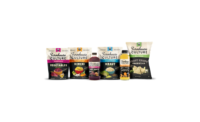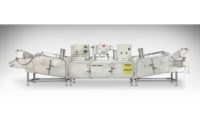![]()
Low-carb Featured at IFT Expo
By Christopher Melchert
SFA Director of Regulatory and Technical Affairs
The popularity of low-carb diets was evident at this year’s Institute of Food Technologists (IFT) Annual Meeting and Expo, held July 13-16 in Las Vegas. An extensive array of ingredients for replacing carbohydrates was featured, along with snacks and other food and beverage products incorporating those ingredients.
A recent estimate shows that 10 million to 32 million Americans are following some type of lower-carbohydrate diet. Sales of low-carb products are currently estimated at $40 billion and are projected to reach $450 billion by 2006.
With low-carb products, the food industry faces several challenges in achieving the taste and texture consumers demand in their products. The food industry has developed several methods of reformulating products to meet these challenges.
Reformulating high-carb foods involves replacing the carbohydrates with ingredients such as proteins, fibers and/or sugar alcohols to produce a low-carb product. Some methods that food manufacturers use to reduce the carbohydrate value in various foods include:
Replacing wheat flour with soy flour, soy protein or wheat protein;
Adding wheat bran, oat bran and other fibers to replace starch; and
Replacing sugar with sugar alcohols or artificial sweeteners.
Replacing wheat flour with soy flour, soy protein or wheat protein;
Adding wheat bran, oat bran and other fibers to replace starch; and
Replacing sugar with sugar alcohols or artificial sweeteners.
A vast array of low-carb cookies, bakery products, drinks, snacks, pasta, sauces and soups were displayed on the IFT expo floor. These products were exhibited by a variety of companies with a vested interest in the low-carb market.
For example, Dairy Management, Inc. (Rosemont, Ill.) created low-carb, high-protein products through the use of dairy proteins. These proteins are added back to foods after the carbohydrate load has been reduced. The use of whey proteins provides an increased protein content to bakery products, snacks, pasta and beverages with a low-carb content. In another approach, Solbar Industries, Ltd. (Israel) and Solae Company (St. Louis, Mo.) used soy proteins to replace the carbohydrate load in several food products.
An innovator in sugar substitutes is Minneapolis-based Cargill, which offers a product called Erythritol. This is a sugar alcohol that replaces simple sugars in baked goods and candy. The use of Erythritol can help lower the carbohydrate content of a variety of foods and is suitable for reduced-calorie and sugar-free foods. Roxlor International (Wilmington, Del.) also uses a substitute sweetener called BeFlora to replace sugars in foods. BeFlora is a blend of sweet fibers derived from beets and soy extracts and is used for low-carb formulations.
TIC Gums (Belcamp, Md.) exhibited Gum Arabic, which is derived from the sap of the African acacia tree and is excellent for carbohydrate replacement. Gum Arabic increases the soluble dietary fiber of a product and can be used as a partial or full replacement of starches in low-carb foods.
Supplements and functional foods also were offered to formulate foods made popular by the low-carb trend. Nutrition 21, Inc. (New York, N.Y.) produces Chromax, an over-the-counter, daily nutritional supplement — chromium picolinate — that, according to the company, controls carbohydrate cravings.
The food industry has reacted to the low-carb trend by launching a variety of new low-carb products or reformulating existing brands to meet the consumer’s desire for these products. One factor that manufacturers may want to consider, though, is the possibility that the low-carb trend has peaked and sales of low-carb products may decrease (see article on food trends on page 42). Although the low-carb lifestyle is not likely to fade away completely, it will produce a shift in the eating habits of some Americans.




